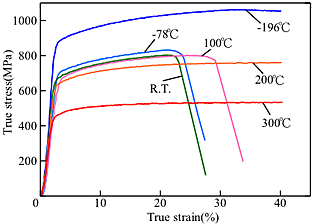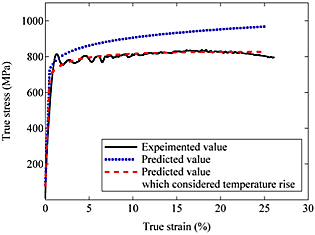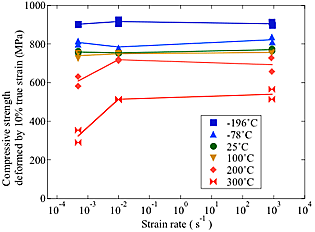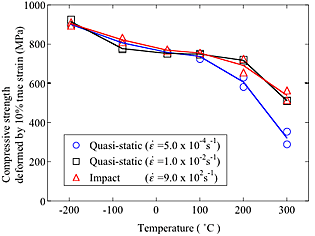Reducing the weight of industrial products is an important concern, particularly in the automotive industry, to improve fuel consumption and guard against the problems of global warming and the depletion of fossil fuels. It is known that aluminum alloys can be used for various automotive body panels because of their low specific gravity. In addition, of all the industrial metallic materials available, aluminum alloys show the greatest strength after age-hardening treatment. In previous studies, several attempts have been made to improve the mechanical properties of powder metallurgy (P/M) Al![]() Zn
Zn![]() Mg
Mg![]() Cu alloys. Recently, a high-strength aluminum alloy named Mesoalite® has been developed by a group from Kyoto University. Mesoalite is made by powder metallurgy utilizing a rapidly solidified method, with the alloy compositions based on 7000-series aluminum alloys. Among the different types of Mesoalite, the Meso10 alloy with a typical chemical composition has a tensile stress of 790 MPa, which is the highest specific intensity of all metallic materials. From a perspective of automotive materials, it is important to clarify not only the static mechanical properties but also the impact mechanical properties in the Mesoalite. In the present study, the effect of strain rate on the compressive properties of Mesoalite was investigated by means of the split Hopkinson pressure bar method. In addition, to use the Mesoalite in automotive materials in various environments, the compressive properties for Mesoalite were also investigated across a wide temperature range.
Cu alloys. Recently, a high-strength aluminum alloy named Mesoalite® has been developed by a group from Kyoto University. Mesoalite is made by powder metallurgy utilizing a rapidly solidified method, with the alloy compositions based on 7000-series aluminum alloys. Among the different types of Mesoalite, the Meso10 alloy with a typical chemical composition has a tensile stress of 790 MPa, which is the highest specific intensity of all metallic materials. From a perspective of automotive materials, it is important to clarify not only the static mechanical properties but also the impact mechanical properties in the Mesoalite. In the present study, the effect of strain rate on the compressive properties of Mesoalite was investigated by means of the split Hopkinson pressure bar method. In addition, to use the Mesoalite in automotive materials in various environments, the compressive properties for Mesoalite were also investigated across a wide temperature range.
In the present study, Meso10 alloy was used with a chemical composition as shown in Table 1. The atomized powder of Meso10 alloy was canned into the aluminum container, and then, pressed using a cold isostatic press (CIP). After the CIP treatment, this piece was hot extruded at 500![]() . The extrusion ratio was set at 10, and the extrusion ram speed was 0.5 mm/s. Compression test pieces with a gage length of 6.0 mm (ls) and a diameter of 6.0 mm were machined using a lathe. All the specimens were solution treated at 490
. The extrusion ratio was set at 10, and the extrusion ram speed was 0.5 mm/s. Compression test pieces with a gage length of 6.0 mm (ls) and a diameter of 6.0 mm were machined using a lathe. All the specimens were solution treated at 490![]() for 7.2 ks, quenched in water, and then, artificially aged at 110
for 7.2 ks, quenched in water, and then, artificially aged at 110![]() for 108 ks (peak-aged condition) without natural aging immediately after the solution treatment.
for 108 ks (peak-aged condition) without natural aging immediately after the solution treatment.
In the present study, the impact compression test was performed using the split Hopkinson pressure bar (SHPB) method established by Kolsky. The SHPB method has become a generally accepted test method for strain rates in the range 102 to 104 s-1. Dynamic stress-strain curves can be obtained by incorporating the elementary one-dimensional elastic wave propagation theory into the SHPB method. Figure 1 shows the setup of the SHPB apparatus for the impact compression test. In the present study, the average strain rate of the impact test was approximately 9.0 ![]() 102 s-1. A quasi-static (QS) compression test was carried out using a Shimadzu-Servopulser testing machine at strain rates of 5.0
102 s-1. A quasi-static (QS) compression test was carried out using a Shimadzu-Servopulser testing machine at strain rates of 5.0 ![]() 10-4 and 1.0
10-4 and 1.0 ![]() 10-2 s-1. In all the strain-rate experiments, the compression test was carried out at room temperature, low temperature, and high temperature. The compression test at low temperature was performed at -196
10-2 s-1. In all the strain-rate experiments, the compression test was carried out at room temperature, low temperature, and high temperature. The compression test at low temperature was performed at -196![]() using liquid nitrogen and at -78
using liquid nitrogen and at -78![]() using ethanol cooled by frozen carbon dioxide. The compression test at high temperature was performed at 100, 200, and 300
using ethanol cooled by frozen carbon dioxide. The compression test at high temperature was performed at 100, 200, and 300![]() using a self-produced electrical furnace. All the compression tests were carried out after maintaining the testing temperature for 600 s.
using a self-produced electrical furnace. All the compression tests were carried out after maintaining the testing temperature for 600 s.
Figure 2 shows the true stress-true strain curves in the QS compressive test at the strain rate of 1.0 ![]() 10-2 s-1 at various temperatures. The QS test was carried out until the true strain of 40% was obtained without compression fracture. It was found that the flow stress decreased with increasing testing temperature.
10-2 s-1 at various temperatures. The QS test was carried out until the true strain of 40% was obtained without compression fracture. It was found that the flow stress decreased with increasing testing temperature.
Figure 3 shows the true stress-true strain curves in the impact compressive test at the strain rate of 9.0 ![]() 102 s-1 at various temperatures. In the present study, the applied true strain was approximately 25% in the impact test. The yielding phenomena and the stress oscillation from the start of the plastic deformation to a true strain of 10% was indicated, but these were not inherent properties of the materials, rather problems with the apparatus.
102 s-1 at various temperatures. In the present study, the applied true strain was approximately 25% in the impact test. The yielding phenomena and the stress oscillation from the start of the plastic deformation to a true strain of 10% was indicated, but these were not inherent properties of the materials, rather problems with the apparatus.
To investigate the effects of the strain rate and testing temperature on the compressive strength, the change in compressive strength as a function of strain rate was plotted (Fig. 4). In the present study, taking the stress oscillation into account, the compressive strength deformed by 10% true strain, which showed non-stress oscillation, was used. When tested in the range from -196°C to 100°C, no increase in compressive strength with strain rate was observed. In general, the aluminum alloy has little strain-rate dependency of the flow stress. The Meso10 alloy also confirmed that the strain-rate dependency of the compressive strength was small.
The change in compressive strength as a function of testing temperature is shown in Fig. 5. As shown in Figs. 4 and 5, a decrease in stress is exhibited at 300°C, regardless of the strain rate. This is because the precipitate that induces the increasing strength was dissolved in the matrix at testing temperatures over 300°C. In addition, when tested at 200 and 300°C, the compressive strength was decreased at a strain rate of 5 ![]() 10-4 s-1 in comparison with other strain rates.
10-4 s-1 in comparison with other strain rates.





